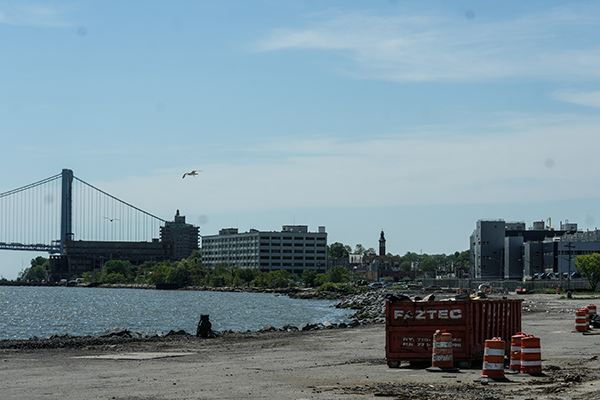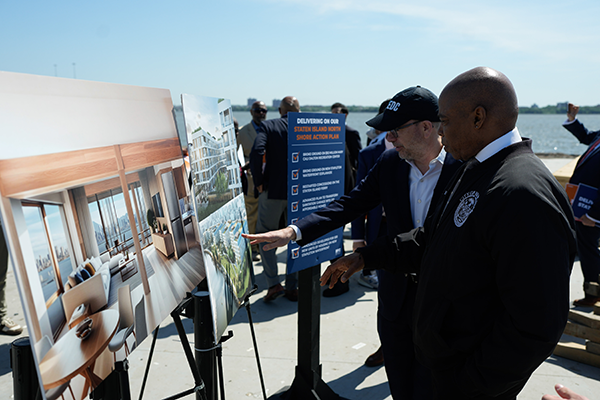KEY POINTS
-
Staten Island project is NYC’s first major mass timber housing development, with over 500 mixed-income units on city-owned land.
-
The NYC Mass Timber Studio accelerator provides technical, regulatory, and educational support to help the design team overcome mass timber construction challenges.
-
Mass timber enables faster, lower-impact construction, supporting affordable housing needs and advancing NYC’s sustainability and green economy goals.
Mass timber is taking a big step in New York City with the recent announcement of a commercial construction project to develop more than 500 mixed-income housing units with the innovative wood product on city-owned land in Staten Island.
“In New York City, this is a huge mass timber project,” says Momo Sun, regional director, WoodWorks, Wood Products Council (WPC).
Only a few small mixed-income housing complexes with no more than 15 units have been specified in mass timber in New York City until now.
Still in its infancy, the Staten Island project by Artimus and the Phoenix Realty Group will be on two vacant properties along the city-owned New Stapleton Waterfront on the North Shore of Staten Island. A quarter of the units will be designated as affordable suites.

New York City Mayor Eric Adams is shown signing a beam with other representatives when announcing the project. The developer’s design team will participate in the NYC Mass Timber Studio to tackle the challenges of using mass timber for the big city project. This accelerator program provides technical and regulatory assistance. Image: NYC Mayor Adams, Flickr
The development team is commencing site investigations and is expected to begin construction in 2027.
The project is the first publicly awarded project to use mass timber at scale in the northeastern U.S.

The Staten Island project by Artimus and the Phoenix Realty Group will be on two vacant properties along the city-owned New Stapleton Waterfront on the North Shore of Staten Island, shown in this image. A quarter of the units will be designated as affordable suites. Image: NYC Mayor Adams, Flickr
Sun says the RFP posted by the City of New York and the New York City Economic Development Corporation (NYCEDC) included a preference for the engineered wood material.
“That is a huge milestone because the EDC or the city has never put a material preference in their RFQs, RFPs.”
To tackle the challenges of using mass timber for the big city project, the developer’s design team will participate in the NYC Mass Timber Studio. This accelerator program provides technical and regulatory assistance.
“It is really a model for how to drive innovation and drive education,” says Bill Parsons, COO, WoodWorks – WPC.
Led by the NYCEDC in partnership with Newlab and the Mayor’s Office for Climate and Environmental Justice, the 10-month program at the studio includes twice-a-month meetings with the design/development team and a monthly “learning workshop” on various mass timber-related topics, Sun says.
The studio assists all of the project participants, including the architect, engineer, contractor, and developer.

New York City recently announced a project to develop more than 500 mixed-income housing units with mass timber on city-owned land in Staten Island. Image: NYC Mayor Adams, Flickr
“We really have to educate everyone,” says Parsons, noting the studio was launched in 2023.
Participants get help on a range of topics, including building code issues, waterproofing details, timber connections, and even where to source materials.
“It really pushes along the permitting and design process, says Sun, adding the NYC Department of Buildings will be on hand to provide assistance to the team.
She says advantages of mass timber over conventional materials for housing include that it requires less labor and erection is much quicker.
“Like the mayor (Eric Adams) has said, the city is desperate for affordable housing or housing in general, so the quicker they can get it up, the quicker people can move in.”
Parsons adds mass timber holds a logistics advantage over concrete because it requires fewer trucks and large equipment to deliver the project.
While it has yet to be determined where the engineered wood materials will come from, several manufacturing plants are in the U.S. southeast, one in Chicago, and others nearby in Canada.
Parsons says that because it is lightweight (considerably less than concrete or steel), the cost of shipping it even long distances should not be prohibitive.
The project is one of several initiatives under Staten Island’s North Shore Action Plan by the city of New York, a four-year effort to invest $400 million in the construction of 2,400 homes over 20 acres of public space.
Mass timber fits into New York City’s Green Economy Action Plan, which lays out a roadmap to growing the city’s green economy.
“We are not only building the affordable homes New Yorkers need but using sustainable materials to reduce our carbon footprint and help turn New York City’s waterways into the ‘Harbor of the Future,’” Adams said in a press release.
Construction economy news and insights you can act on.
Subscribe to our economic reports
About ConstructConnect
At ConstructConnect, our software solutions provide the information construction professionals need to start every project on a solid foundation. For more than 100 years, our insights and market intelligence have empowered commercial firms, manufacturers, trade contractors, and architects to make data-driven decisions and maximize productivity.
ConstructConnect is a business unit of Roper Technologies (Nasdaq: ROP), part of the Nasdaq 100, S&P 500, and Fortune 1000.
For more information, visit constructconnect.com
